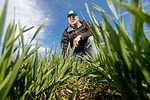Economics
4 Questions to Consider for Prevent Planting Cover Crops
NRCS conservation agronomist shares important points on deciding when to seed cover crops and which species to choose.
Read More
When Do Cover Crops Pay Off?
A new report from USDA Sustainable Agriculture Research & Education explores cover crop profitability.
Read More
Cover Crops Planted on More Indiana Acres Than Any Other Commodity Crop
Indiana farmers planted more than 1 million acres of cover crops in 2018.
Read More
Proposed FEEDD Act Enables USDA to Allow Producers to Graze, Hay or Chop Cover Crops for Livestock
Cover crops could be harvested before Nov. 1 in the event of a feed shortage due to excessive moisture, flood or drought.
Read More
Texas Panhandle Tour Explores Multi-Species Cover Crops
No-Till on the Plains bus tour scheduled from July 30-August 1.
Read More





